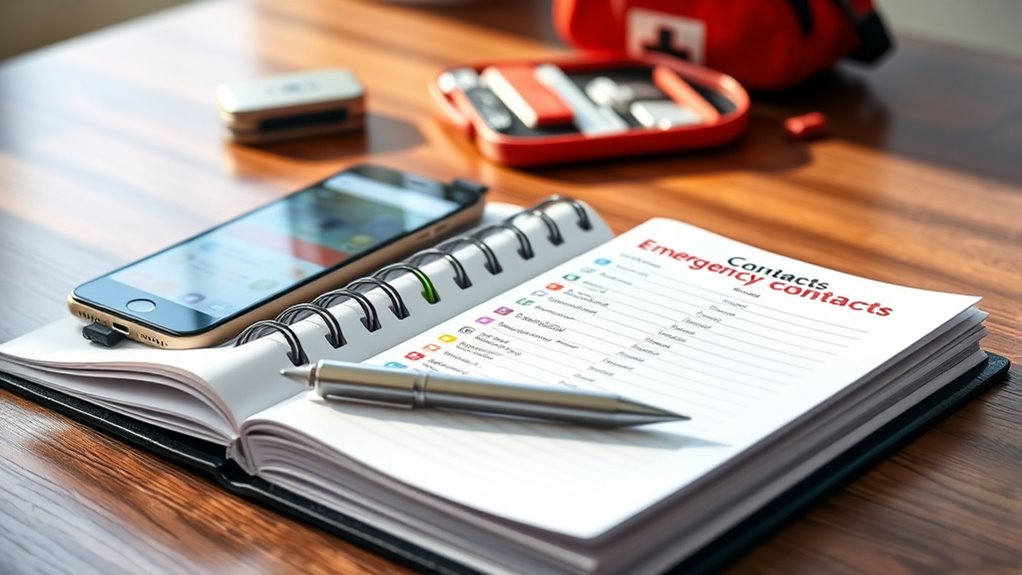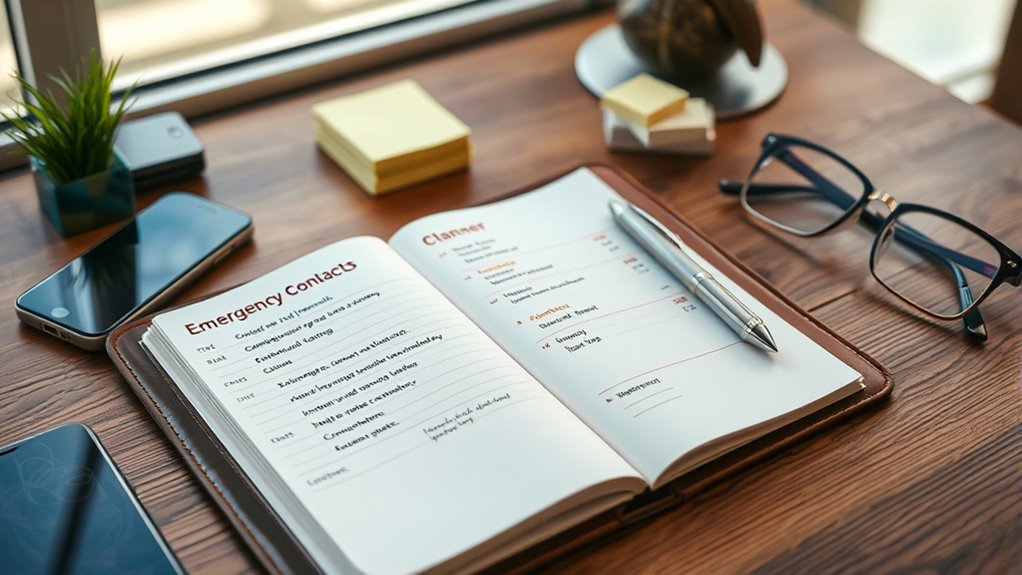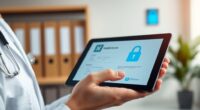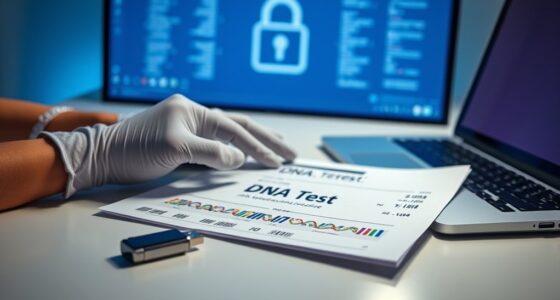To organize your emergency contact information effectively, store your contacts in secure digital platforms like cloud services or dedicated apps that are easy to access quickly. Regularly review and update the details to guarantee accuracy, and consider using smartphone emergency contact features for instant access. Share your info with trusted individuals and set reminders for updates. If you keep these tips in mind, you’ll be better prepared—continue to learn more on how to make your contacts even safer.
Key Takeaways
- Use digital tools like cloud storage or dedicated apps for secure, centralized contact information.
- Regularly review and update contacts to ensure accuracy and current details.
- Include essential info such as names, phone numbers, emails, and medical details for quick access.
- Protect sensitive data with passwords and limit access to trusted individuals and emergency responders.
- Share updated contact lists with family and friends for redundancy and reliable access during emergencies.

Having your emergency contact information organized and easily accessible can make all the difference during a crisis. When an emergency strikes, every second counts, and knowing that your contacts are stored securely in an accessible way can help first responders or loved ones reach out quickly. Digital storage options are invaluable here because they allow you to keep multiple contact details in one safe, organized place. You might consider creating a dedicated document on your phone, tablet, or cloud service that includes names, phone numbers, email addresses, and any relevant medical or allergy information. Using cloud storage ensures your data is protected and accessible from any device, whether you’re at home or on the go. These digital options also simplify updating your contacts, as you can edit information instantly without rummaging through paper files or memorized details. Regularly reviewing your contact list helps maintain its accuracy and ensures that emergency responders have the most current information. To keep your emergency contact list current, you should regularly review and update your information. Contact update methods are essential to guarantee accuracy. Some effective methods include setting reminders to review your contacts every few months, subscribing to calendar alerts, or using apps with built-in update prompts. Many smartphone contact apps allow you to add labels or notes indicating the relationship or medical conditions, making it easier for responders to understand the context quickly. If you use a shared digital document or cloud service, make sure it’s password-protected to prevent unauthorized access, but also accessible to trusted family members or emergency services if needed. This balance between security and accessibility is crucial. Ensuring your contact information is up-to-date can prevent delays in emergencies and improve response times. Another practical approach is to share your emergency contact information with close family members or friends, especially those who may need to access it in your absence. Some people store their emergency contacts in their phone’s emergency contact feature, which can be accessed even if the phone is locked. This feature is often overlooked but can be lifesaving. Additionally, consider using specialized apps designed for emergency preparedness, which allow you to store and update contacts securely and share them with emergency responders if necessary. Whichever method you choose, the key is consistency. Regularly updating your contact list and ensuring your preferred contact methods are current prevents confusion and delays during urgent moments.
Frequently Asked Questions
How Often Should I Update My Emergency Contacts?
You should review your emergency contact information at least once a year to make certain accurate contact frequency and keep update reminders in mind. Life changes, like moving or new phone numbers, make updates essential. Regularly checking your contacts helps you stay prepared, so set a calendar reminder to review and update your emergency contacts periodically. Staying proactive ensures you can reach loved ones quickly in an emergency.
What Information Is Essential to Include in Emergency Contacts?
Think of your emergency contacts as your safety net. You should include their full names, phone numbers, and relationship to you. Don’t forget to add medical history and allergy details, which can be lifesavers in a pinch. Also, include their address and any special instructions. This way, when seconds count, help arrives prepared, and your contacts have all they need to assist effectively.
How Can I Securely Store Digital Emergency Contact Info?
To securely store digital emergency contact info, you should use cloud storage with strong password protection. Choose a reputable service that offers encryption and two-factor authentication for added security. Regularly update your passwords and avoid sharing access. Consider creating a backup on an external device, like a USB drive, kept in a safe place. This way, your critical contact details stay protected and accessible when needed.
Who Should I Prioritize as Emergency Contacts?
Think of your emergency contacts as your trusted crew in a ship’s crew. You should prioritize your core family members, like a captain relies on their first mates, because they’re your immediate support. Next, include close friends who can step in if needed. Balance your priority contacts between family and friends, ensuring your crew is ready for any storm. Always keep their info secure and accessible.
What Should I Do if My Emergency Contact Is Unreachable?
If your emergency contact is unreachable, don’t panic. First, activate your emergency contact backup, such as a trusted friend or family member. Then, try alternative contact methods like email, social media, or messaging apps. It’s smart to keep multiple ways to reach your emergency contacts, ensuring you’re prepared. Always have a plan in place, so you can quickly find someone to assist you when needed.
Conclusion
By organizing your emergency contacts, you hold the key to your safety’s lighthouse, guiding others through the storm when you’re in peril. Your list becomes a sturdy anchor amid chaos, a beacon of hope in dark times. When life’s tempests strike, this organized system stands as a silent guardian, symbolizing readiness and connection. Keep it clear and accessible—because in moments of crisis, your preparedness can illuminate the path back to calm.









